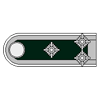Hey Bob,
Your "fundamental questions" go right back to the point I made in my first reply about the philosophies of judging and competition.
As mentioned, AMPS really has no categories except for display purposes. So, there's one approach or philosophy. The categories that AMPS has are only to organize the models for display so that, for instance, WWII armored vehicles that were on the battle field together are displayed together.
In the AMPS system of organization, sf-fi, fantasy, and hypothetical vehicles of all strips are displayed together because of their common characteristic of never having actually existed as real vehicles.
Prototypes by their nature of having actually been manufactured (in at least one example) are displayed with the other "real" vehicles organized by historical time periods. For other vehicles, if a model-builder can document the actual (or likely) existance of the real vehicle, it will go in the appropriate historical (or technical) category for display. If not, then the model will be considered to represent a totally hypothetical vehicle, and then it will be displayed in that category.
There are some other display groupings (categories), but this is the over arching idea - category organization has little or nothing to do with competition and everything to do with allowing the viewer to compare and contrast historically (or technically) related subjects.
Again, as mentioned, AMPS really has no "competition" in the sense of winners and losers in the regular categories. The hypothetical AFV is judged against the exact same criteria as the historical AFV and has exactly the same opportunity to earn a medal.
IPMS, on the other hand, approaches the model show as a true competition, with winners and losers in each category. Therefore, as I also mentioned, the more categories, the more winners. Of course, for someone to win, someone else must lose. So, to reduce the numbers of losers (a subtile but important distinction) you make more categories.
As I also mentioned, the desire of most (if not all) IPMS contest organizers is to have as many categories as they can possibly afford. As you observed, this makes for more "fun" and participation. The fewer people who go away un-happy (i.e the fewer losers), the better.
Unfortunately, those same IPMS contest organizers run into a wall when it comes to how many awards they can afford, and so they also have to make the hard choices between which groups of model-builder-entrants they want to please with categories (and awards) tailored to their particular, narrowly defined interests.
Most IPMS contests already have well developed and tried category lists. These are based largely on pleasing the largest number of potential and likely contest entrants as possible.
It really is a zero-sum game for most IPMS clubs when it comes to adding and subtracting categories. For a new category to be added, an older category must be dropped. I can tell you from first hand experience, the discussions and decisions about which categories to keep, which to drop and which to add takes place before each contest and is something that is agonized over.
There is a saying that "all politics is local," and the same is true with most model contests. Hurt feelings, egos, pride, animosities, personality conflicts, etc, etc, etc, are buttons that are easily pushed by the wrong decisions and choices. Those hard feelings can (and often do) also last a long time and poison the local modeling scene for literally years.
(I can tell you some true stories about animosities between model clubs and individuals that would blow you mind! Yes, it's a hobby, but that doesn't mean that some guys don't take it to extremes...)
Therefore, these category decisions are considered very important, and changes are usually approached very conservatively and with care. Entrenched special interests and local preferences can and do inhibit change.
In the end, the best chance that you (or anyone) has in getting a category change in an IPMS show is to become involved in the local IPMS scene. This is where the decisions are made and where individual modelers can (and do) influence things. Volunteer to judge when you attend any show, become a member of a local IPMS chapter, and get involved in helping to run the local shows.
The same applies to AMPS - join AMPS and attend and participate in AMPS shows as a judge, runner, table captain, etc. If there's an AMPS chapter in your local area, join it.
Model clubs and contests are first and foremost social events - You really have to be involved first hand if you want to influence things like category organization. Just showing up, registering, and paying your entry fees is not really the kind of participation that has much influence.
Attending the local club's meetings, month after month, and volunteering to plan, organize, set-up, and run a contest on the other hand, will give you some say in how that contest is run.





























